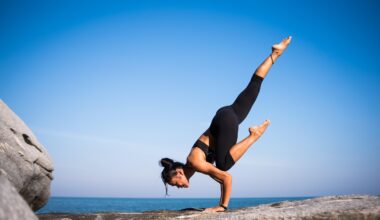Balance Training Tips to Prevent Falls at Home
Balance training is essential for everyone, especially for those who are older or have medical conditions. Engaging in regular balance exercises can significantly reduce the risk of falls. It is vital to create a space at home that is conducive to such workouts. Ensure that floors are free from clutter and inconsistencies. This may be as simple as picking up a stray shoe or ensuring that rugs are secured properly. It might sound basic, yet these small changes can improve your overall safety. Effective balance training can be achieved through various methods, including dynamic and static exercises. Consider incorporating activities that engage multiple muscle groups, as they promote stability. Activities like yoga and tai chi are excellent options, as they focus on control and mindful movement. Always ensure that you wear supportive footwear and practice challenging exercises with a safety net in mind. If available, work with a trainer initially who can guide you through the necessary techniques to perform the exercises correctly. Ultimately, investing time in balance training will enhance your strength and confidence, making your home a safer environment for daily activity.
To enhance your balance through workouts effectively, it’s crucial to focus on specific equipment that can aid in your training. Incorporating items like a balance board can add an exciting challenge to your routine. It helps to engage your core while promoting stability. Resistance bands are another excellent tool; they can be used in various exercises, making them versatile. Stability balls are beneficial for not only improving your balance but also enhancing your core strength. To maximize your home workout space, create a dedicated area where you can perform these exercises without interruptions. Setting up your equipment and ensuring it is easily accessible can inspire you to maintain a consistent practice. It might also be beneficial to document your progress. Keeping a fitness journal can help you stay on track and motivate you to continue with balance workouts. Over time, you will likely notice improvements in your stability and mobility, which are essential for daily tasks. Another recommendation is to incorporate balance training into your existing workout routine, gradually increasing difficulty as your capabilities improve, creating a comprehensive approach to overall fitness.
Common Balance Exercises
Implementing specific exercises into your balance training regimen is vital for preventing falls at home. Stand on one leg while holding onto a sturdy chair for support initially. Gradually decrease reliance on the chair as you gain confidence. Engaging in heel-to-toe walking is an effective method to improve your stability; it can easily be done along your living room floor. Balancing on a flat surface is excellent, but consider experimenting with uneven surfaces, such as standing on a cushion or a foam pad. In addition, integrating strength training exercises enhances muscle endurance, which translates to better balance. Lunges and squats can help with your strength and stability while promoting overall fitness. Active movements that involve turning your head can improve your stability significantly. Another effective exercise is the ‘T’ stand, where you lift one leg sideways and hold for as long as possible. As your confidence builds, challenging yourself with longer holds will yield greater results. Combining these exercises regularly will promote not only balance but also coordination and body awareness essential for everyday tasks, ultimately providing a more secure living environment.
It’s also crucial to incorporate stretches into your daily routine to ensure overall flexibility and balance. Flexibility is directly related to preventing falls since a well-stretched muscle can respond better to sudden movements. Simple stretches for your hamstrings, calves, and quadriceps can be highly beneficial. Develop a stretching routine focusing on each major muscle group, aiding in your balance training endeavors. One effective stretch is to reach toward your toes while standing; this engages multiple muscles and promotes balance. Additionally, consider incorporating yoga into your routine. The postures found in yoga not only improve balance but also promote mental focus, crucial for maintaining stability. If you are new to yoga, consider participating in an online class or following along with video tutorials at home to gain guidance. Socially, practicing with friends or family is an ideal way to enjoy the activity while supporting one another. As you strengthen your muscles and enhance flexibility through these practices, taking small daily steps can significantly contribute to your overall balance, offering long-term benefits to your lifestyle.
Safety Precautions While Training
When embarking on your balance training journey, it is vital to keep safety in mind. Ensure that your workout area is well-lit and free from obstacles that could increase your risk of falling. Removing slippery mats or ensuring they have proper grip can significantly enhance your safety while performing exercises. Always warm up before engaging in balance-specific activities; this increases blood flow and prepares your muscles for the workout ahead. Stay hydrated throughout your training to maintain energy levels and reduce the risk of dizziness. Additionally, consider having a spotter or someone nearby if you are trying challenging movements for the first time. As you progress, listen to your body, and never push yourself too far too fast. Here, smaller increments are crucial; it’s better to focus on doing fewer reps correctly than to risk injury due to overexertion. Should you feel any pain during exercises, it’s essential to stop and consult a medical professional or a physical therapist for guidance. Regularly crossing off these safety precautions will ensure that your balance training remains effective, enjoyable, and most importantly, safe, promoting a healthier at-home routine.
Creating a supportive community around your balance training efforts can greatly enhance motivation and consistency. Consider joining local or online groups dedicated to fitness or elder wellness. Group classes often provide both instruction and camaraderie, essential for motivation. Social support can make the experience enjoyable and help make balance training a regular part of your life. Additionally, friends or family can participate with you, transforming the training into a fun, social event rather than a chore. Share your goals, progress, and struggles with others; it creates an atmosphere of accountability. Utilizing technology can also help keep you engaged. Fitness apps often include balance training workouts, track progress, and offer virtual coaching. Engaging in these platforms can accelerate your learning and provide new perspectives on traditional exercises. Eventually, tracking your improvements will boost your confidence. Visualization techniques can be useful; picturing yourself completing an exercise with ease can positively impact performance. Thus, arm yourself with these supportive avenues, transforming your approach to fitness from solitary to inclusive, fostering not only physical strength but also emotional resilience in the face of challenges.
Long-Term Benefits of Balance Training
Incorporating balance training into your daily routine yields numerous long-term benefits that go beyond fall prevention. Improved balance translates into better functional mobility in everyday life, allowing you to perform daily tasks with greater ease and confidence. Maintaining strength and stability reduces the risk of injuries, which can significantly impact overall health. Increased core strength from balance exercises can alleviate back pain, contributing to better posture and alignment. It also enhances your athletic capabilities, whether you’re participating in sports, hiking, or simply walking. Moreover, balance training promotes better coordination and body awareness, which are vital in preventing accidents during rapid movements. This awareness extends to other physical activities, leading to improved performance across various sports or hobbies you might enjoy. Psychological benefits include enhanced self-esteem and confidence, as you gain mastery over your body and movements. Socially, involvement in group classes can develop meaningful connections with others pursuing similar goals. Overall, the rewards of balance training extend to your physical prowess, mental well-being, and social engagement, creating a holistic approach to wellness that is deeply integrated into your lifestyle.
As you engage in your journey towards improved balance at home, remember that consistency is crucial for lasting change. Set aside dedicated time for your workouts to establish a routine. Having regular practice will ensure your progress remains steady. Simultaneously, assess your environment periodically, ensuring it continues to support your balance training efforts. Remember to incorporate variety in your exercises to keep your routines fresh and engaging. Experiment with new techniques or exercises to discover what resonates most with you. Avoiding monotony is essential in maintaining motivation. Include feedback on how each exercise feels in your journal, which can significantly enhance your learning curve. Celebrate milestones, no matter how small; acknowledgment can boost your morale. It’s also vital to remember that balance is not a finite goal; it’s a lifelong journey requiring ongoing dedication. Make your training holistic and enjoyable; balance exercises can coexist with other activities and hobbies. Ultimately, fostering a routine that allows for both progress and enjoyment will enable you to invest time wisely in your health and ensure you remain on track to enjoy a safer and healthier lifestyle.


